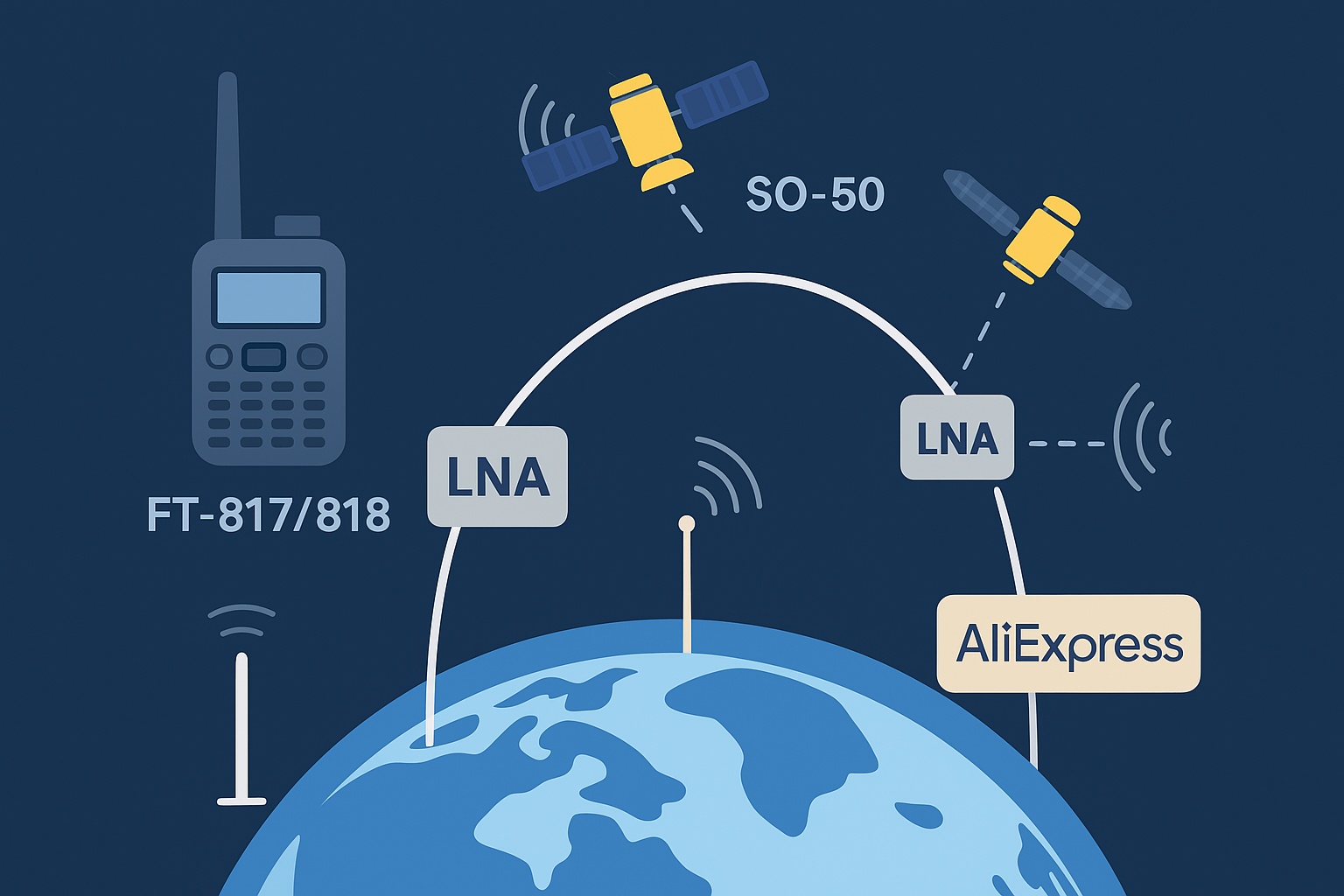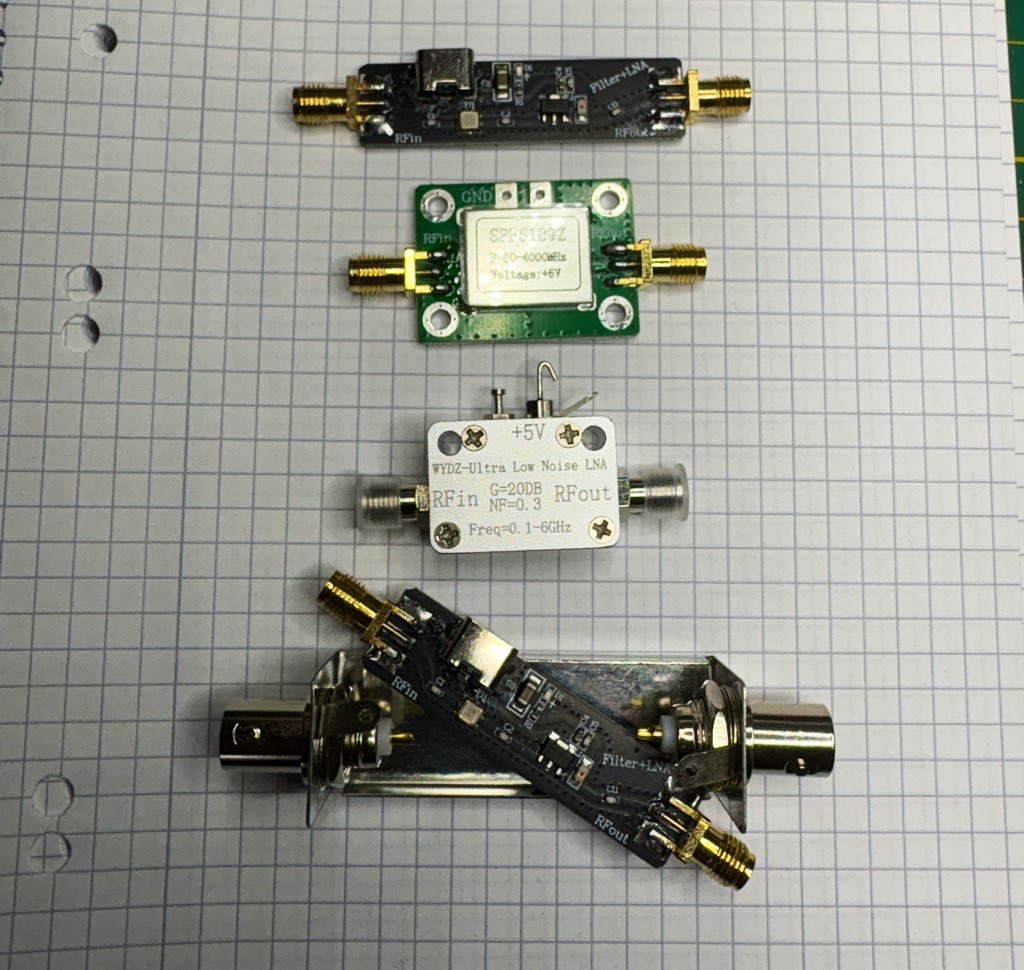Introduction
Working LEO satellites with small portable rigs is a lot of fun. Radios like the Yaesu FT-817/818 and the Icom IC-705 are extremely popular because they are lightweight, cover both 2 m and 70 cm, and are easy to use in the field.
But there is a catch: their receivers are not very sensitive on VHF and especially UHF. On weak satellite downlinks, this lack of sensitivity becomes a real problem. That is why external Low Noise Amplifiers (LNAs) are so valuable.
In this article, I want to share my first tests with inexpensive Chinese LNAs from AliExpress. These are globally available, very low cost, and could help hams everywhere — including those in developing countries — to improve their satellite reception dramatically.
This article will be continuously updated as I test more LNAs and collect measurement results.
Why LNAs Matter for LEO Satellites
When receiving weak downlink signals, the noise figure (NF) of the receiver is critical. A lower NF means that the signal is more audible above the noise floor. Unfortunately, the portable radios we love are not strong performers here.
Receiver Noise Figure Comparison
When I started experimenting with Chinese LNAs for LEO satellite operation, I quickly realized why they make such a difference. Many of the popular portable radios are simply not very sensitive on 2 m and 70 cm – especially when their internal preamps are switched off. The following measurements show clearly why an external LNA can be a game-changer, particularly for radios like the FT-818 or IC-705. By contrast, radios such as the IC-9700 and IC-910H already perform better out of the box, but even they can benefit from a good masthead preamp.
As the numbers show, the FT-818 and IC-705 suffer from significantly higher noise figures, especially with the internal preamp switched off. An external LNA is almost mandatory in these cases. In contrast, the IC-9700 and IC-910H already offer much better performance thanks to their low NF, though even they can benefit from masthead amplification / LNA.
Data compiled by DK9JC
Sources: AB4OJ, OZ9AAR, DL3JOP
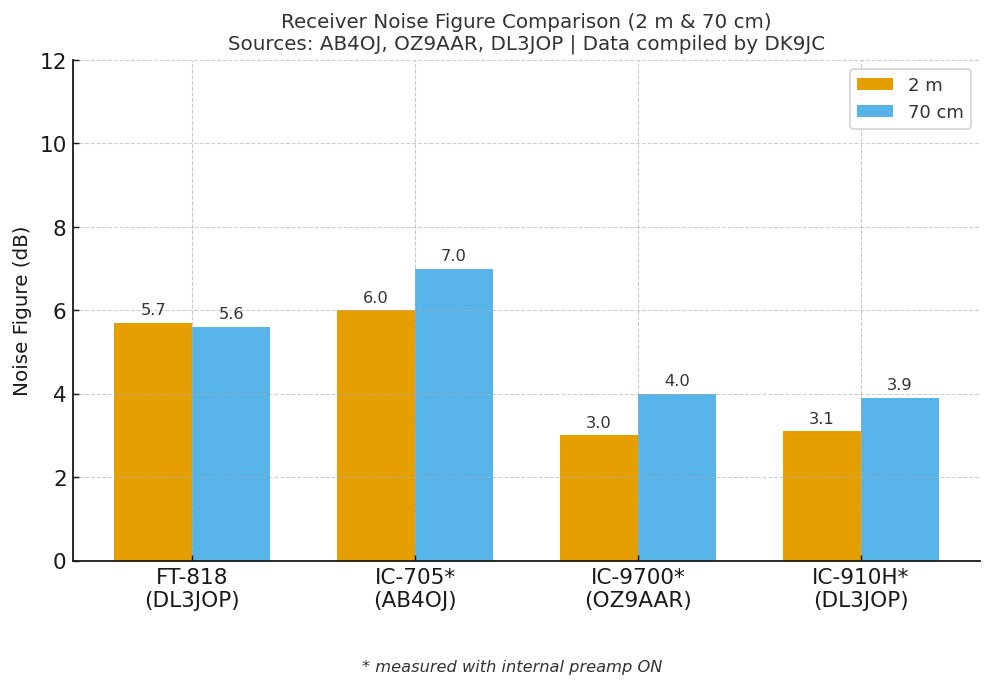
Noise Figure Impact with External LNA
Using the results calculated by OZ9AAR with his SimpleCalc tool, I prepared a visualization to show the effect of placing a low-noise, high-gain preamp in front of different radios.
The outcome is impressive: once the LNA is added, all radios — from basic portables to high-end transceivers — reach almost the same effective noise figure of about 1 dB.
This clearly demonstrates that, for satellite operation, the choice of radio becomes much less critical when such an external LNA is used.
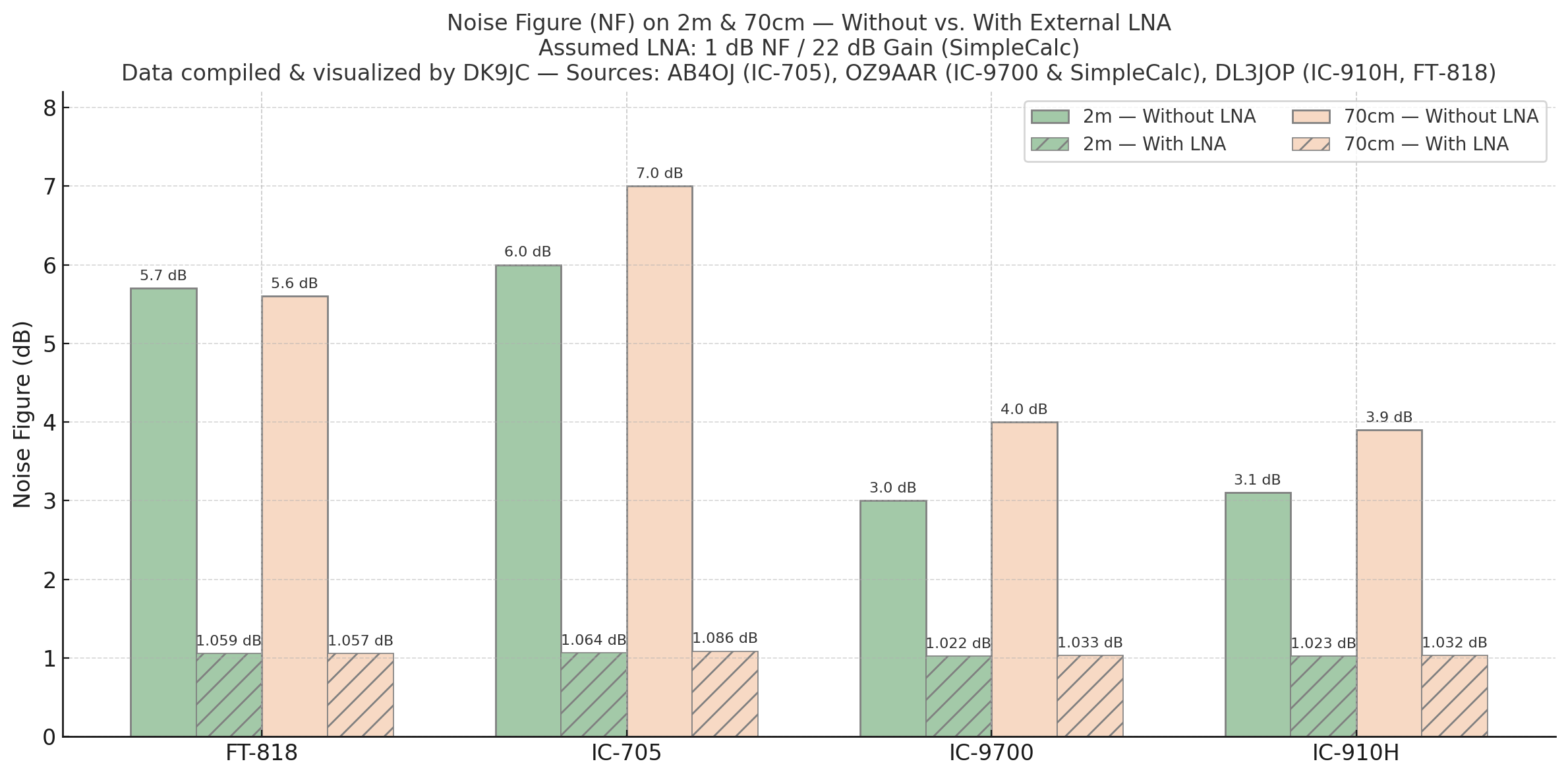
First LNA Tested – 433 MHz SAW-Filtered LNA
This compact LNA includes a SAW filter at the input, powered via USB-C at +5 V.
- Manufacturer specs: Gain 23 dB, NF 1.2 dB
- My measurement: 24.7 dB gain on 70 cm (HP VNA)
- Price: €8.99
I modified the first tested LNA (the 433 MHz SAW-filtered model) for better mechanical stability and shielding:
- Removed both SMA connectors and the USB-C 5 V input with hot air.
- Installed the PCB into a shielded metal enclosure.
- Added BNC connectors for RF IN/OUT.
- Integrated a 7805 linear regulator (+100nF C) inside the box for a clean 12-14V supply.
After these changes, I performed a new measurement with my HP 8752A VNA on .
Results: strong suppression at 145.8 MHz (≈−40 dB), a clean passband with about +24.7 dB gain around 436 MHz, and again strong attenuation at higher out-of-band frequencies (≈−25 dB at 736 MHz).
The device is marked 3M3009, very likely a Qorvo TQP3M9009 or a high-quality clone. For reference, the Qorvo datasheet specifies ≈25.7 dB gain at 500 MHz. My measured value of 24.74 dB at 436 MHz is essentially in line with this.
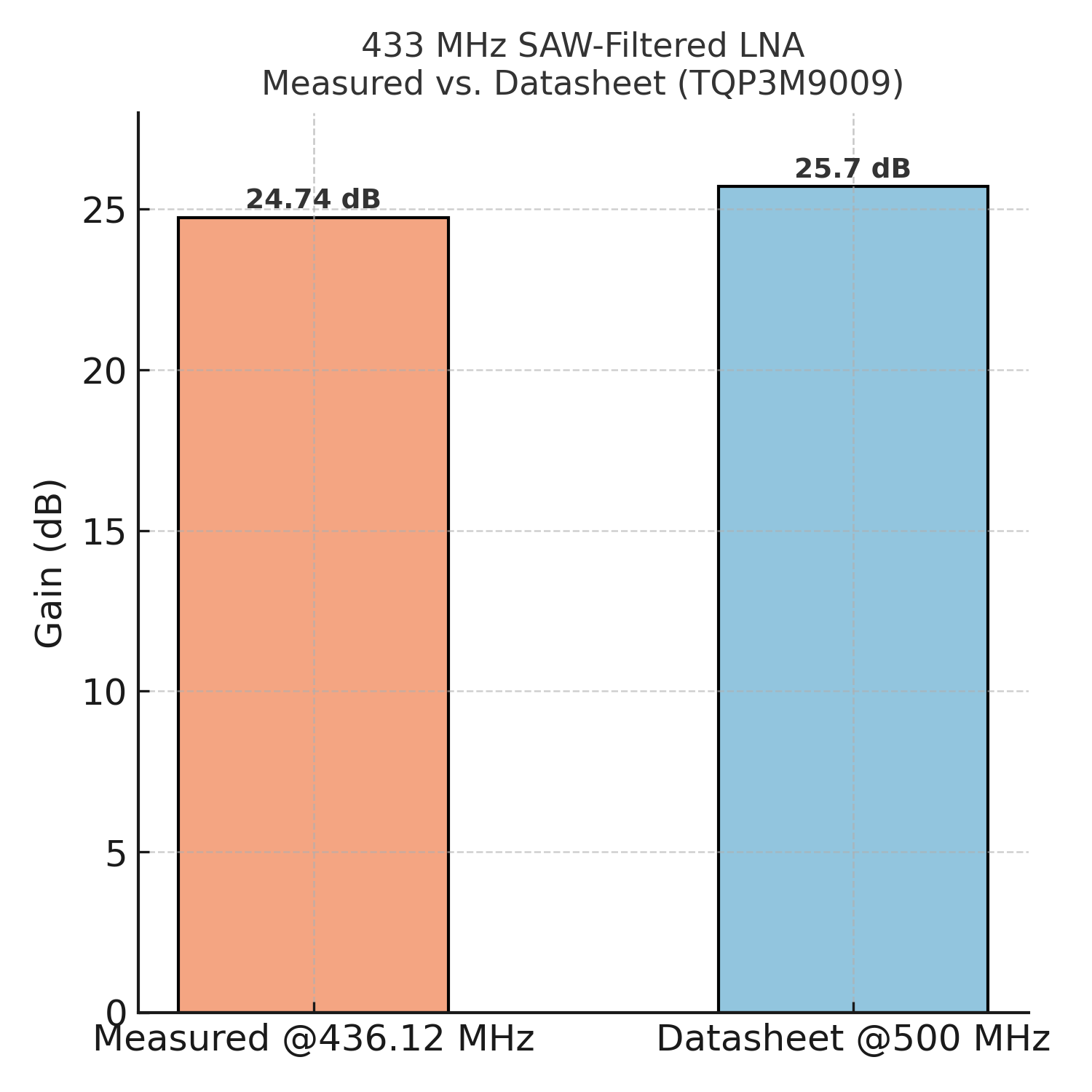
This demonstrates that even a very affordable Chinese LNA can deliver performance remarkably close to the original component, while the SAW filter provides excellent out-of-band rejection — making it an excellent dedicated 70 cm preamp for satellite operation.
Real-World Test with Handheld Scanner
I also tried the LNA in a very simple setup using my Yupiteru MVT-7100 handheld scanner. On a steady signal that registered about S3 without the LNA, enabling the preamp raised the level to S6–S7. Since one S-unit typically corresponds to about 6 dB, this increase of roughly 3 to 4 S-units equals about 18–24 dB gain. This matches very well with the laboratory measurements of the LNA (≈24.7 dB around 436 MHz). This quick on-air test confirmed that the small preamp makes a dramatic difference, even with a modest hand scanner.
Real-World Test – SO-124 FM Satellite
A few days ago I worked F5RRS on a low pass of SO-124 using a Yupiteru MVT-7100 handheld receiver that I had picked up second-hand.
- LNA off: I could not hear him at all.
- LNA on: easy QSO, very strong difference.
This was a night-and-day improvement, proving how effective even a simple low-cost LNA can be.
For context, the Yupiteru MVT-7100 is a wideband handheld scanner covering 530 kHz to 1650 MHz (RigPix, Manualzz). Despite being released in the late 1990s, its sensitivity on UHF (~0.5 µV for 12 dB SINAD at 435 MHz) translates to a rough noise figure of about 6–8 dB. That is actually in the same ballpark as the modern Icom IC-705 with its internal preamp switched on (~7 dB NF on 432 MHz, AB4OJ measurements).
The key point: although the IC-705 is a modern full-featured SDR transceiver for HF, VHF, and UHF, in terms of raw receive sensitivity on 70 cm the inexpensive Yupiteru scanner plus a small external LNA can perform surprisingly well. Without the LNA, the MVT-7100 struggled. With the LNA inline, it became fully usable for LEO satellite contacts—showing that low-cost gear, when combined with the right preamp, can rival much more expensive setups.
Second LNA – SPF5189Z Wideband
This is a tiny wideband LNA based on the SPF5189Z chip.
- Frequency range: 50–4000 MHz
- Advertised gain: ~20 dB
- Advertised NF: 0.6–1.0 dB
- Price: only €2.80
SPF5189Z Green LNA (0–4000 MHz)
I tested a low-cost $2.99 SPF5189Z green LNA module (0–4000 MHz, +5 V) that originally came with SMA connectors. Bare-module measurements with an HP 8752A VNA showed about 21.7 dB gain at both 145 MHz and 435 MHz, 17.6 dB at 1 GHz, and 9.3 dB at 2.4 GHz.
With a Mini-Circuits BLP-200+ low-pass filter (≈0.4 dB insertion loss at 145 MHz) in front and a Mini-Circuits BBP-140+ band-pass filter (≈2.0 dB insertion loss at 145 MHz) behind the LNA, the final gain at 145 MHz was about 19.4 dB. Out-of-band suppression was measured as −68 dB at 435 MHz, −79 dB at 1.09 GHz, and −67 dB at 2.4 GHz, which matches the filter datasheets when accounting for adapter and cable losses.
That looks very good so far in the lab.
Estimated noise figure: bare module ≈0.6–0.8 dB; with filters and connectors ≈1.1–1.3 dB.
Final build: the module was mounted in an Altoids tin with BNC connectors and powered via a Motorola 7805 regulator (12–14 V in → 5 V out).
Graphic of results created by DK9JC.
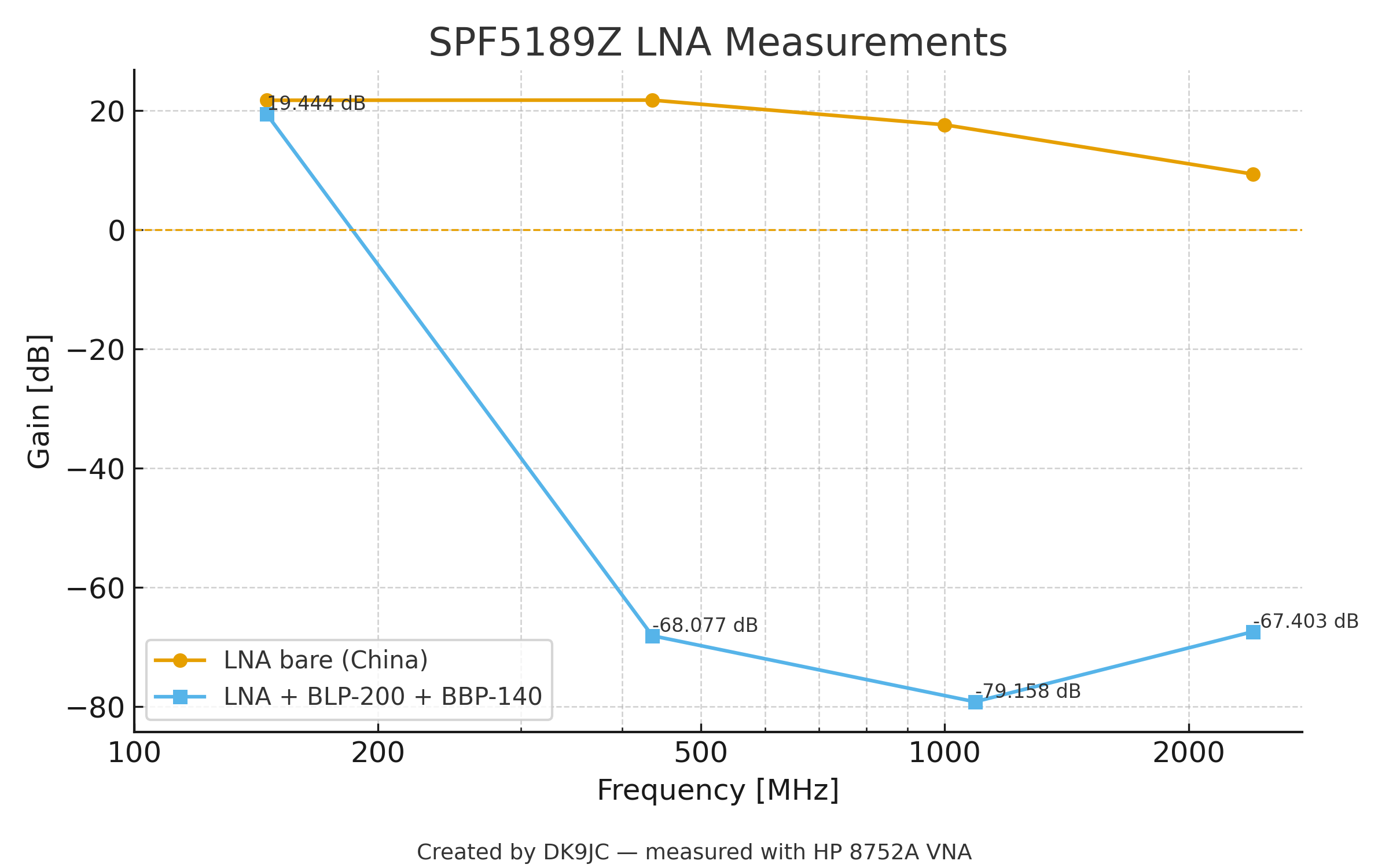
I have not tested it yet on air, but it will be fascinating to see how this ultra-budget design performs on 2 m and 70 cm.
Third LNA – 0.3 dB NF Broadband
This model claims to cover 100 MHz to 6 GHz, with 20 dB gain and an extremely low 0.3 dB noise figure.
- Price: €21 (including shipping)
- Delivery time: about 1 week
- Specs: 0.1–6 GHz, 20 dB gain, NF 0.3 dB (claimed)
This LNA was recently tested in CQ DL magazine and reviewed in detail by DD1US: 📄 DD1US Test Report (PDF)
According to his findings, the performance is indeed impressive for such a low-cost device. My own tests are pending and will be added soon.
Operating Tips
One advantage for satellite operators is that many of us already use two rigs (for example, two FT-817s). In that setup, the LNA can simply stay permanently in front of the receive-only rig, while the other radio is used for transmit. No switching or relays are needed.
Conclusion
The first tests clearly show that even very inexpensive LNAs from AliExpress can transform the satellite performance of radios like the IC-705 and FT-817/818.
- The €8.99 SAW-filtered LNA already enabled a successful SO-124 QSO that would not have been possible otherwise.
- The €2.80 SPF5189Z LNA and the €21 0.3 dB NF broadband LNA are next on the bench.
For less than the price of a pizza, you can add several dB of sensitivity to your satellite station. And because AliExpress ships worldwide, these tools are accessible not just to hams in Europe or North America, but also to operators in developing countries.
This post will be continuously updated as I test more LNAs and publish new results. Stay tuned!
What’s Next?
This article is far from finished — two more LNAs are coming up for testing:
- SPF5189Z Wideband LNA (50–4000 MHz, ~20 dB gain, ~0.6–1 dB NF). --> On Air test is still pending.
- Ultra-wideband Preamp (0.1–6 GHz, 20 dB gain, ~0.3 dB NF) — as reviewed by DD1US. --> it is measures, article has to be updated.
Stay tuned — VNA plots, gain/NF tables, and real-world satellite tests are on the way.
